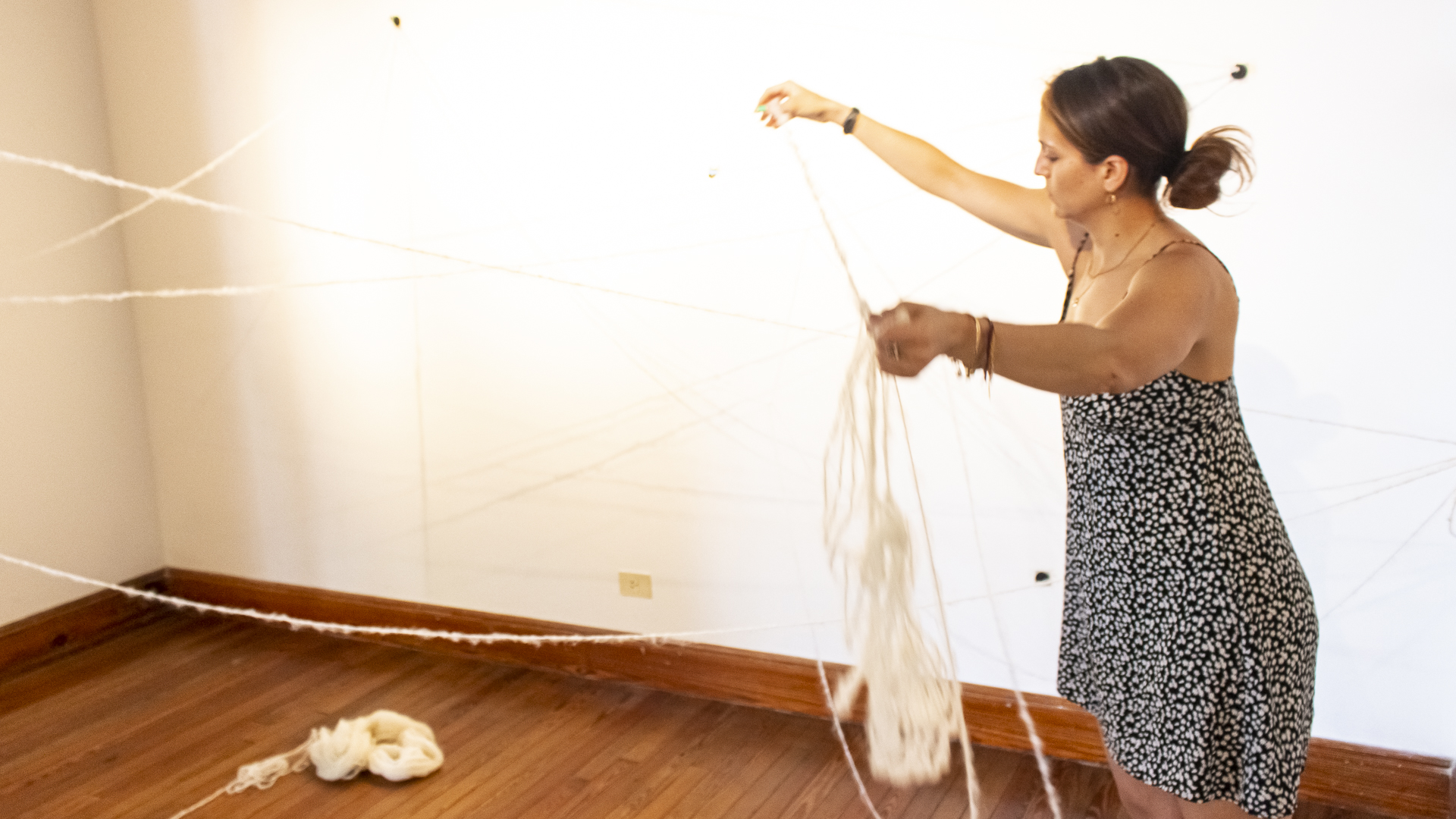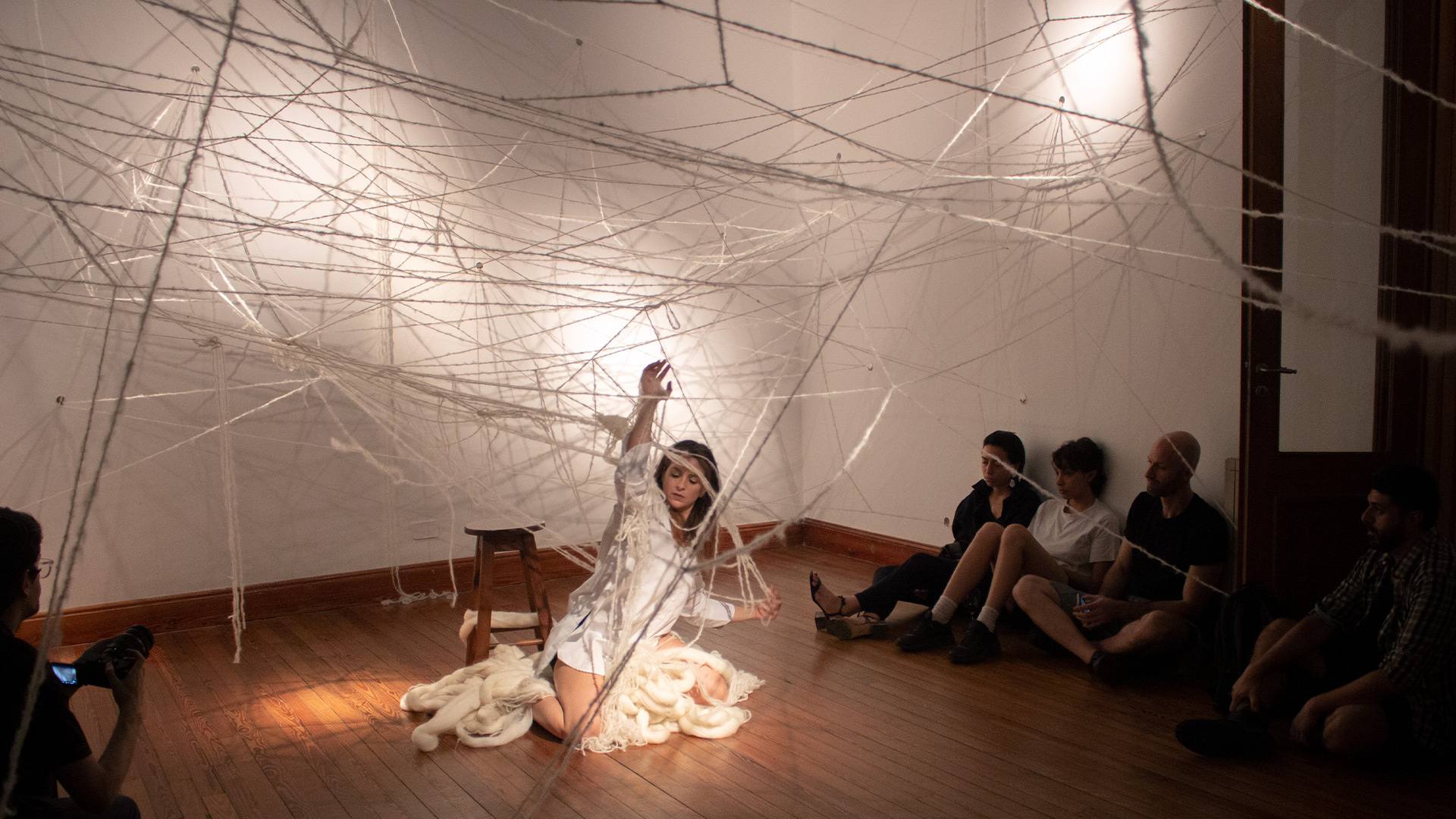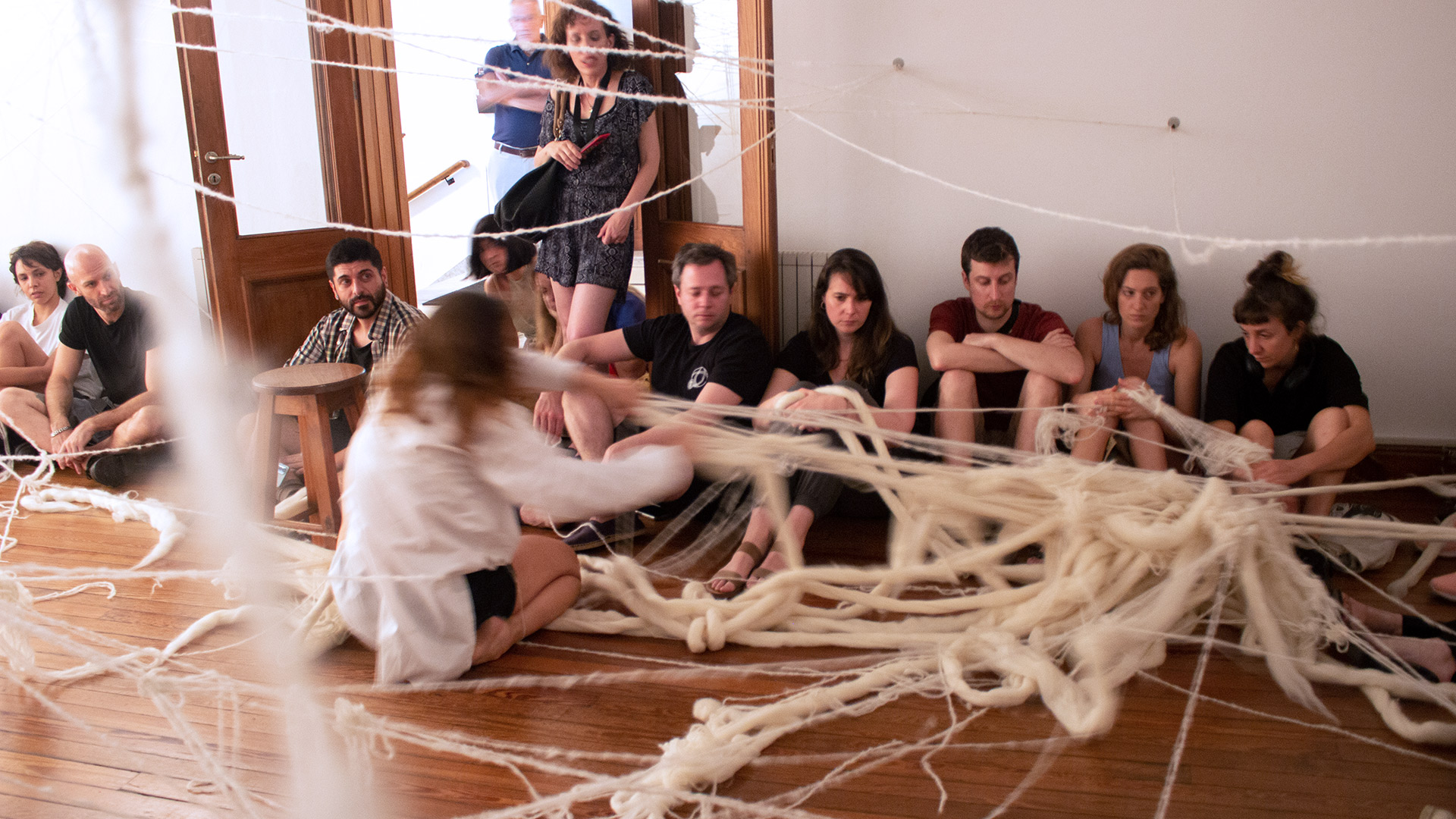Artists
Canada
Ariana Pirela Sánchez
The Visible and the Imperceptible
06.02.23 01.03.23
Ariana Pirela Sánchez (Venezuela-Canada) has a degree in Communication with a major in Audiovisual Arts from the Andrés Bello Catholic University in Caracas (Venezuela) and completed professional training in contemporary dance at L’École de danse de Québec (Canada).
During her residency at ´ace, Ariana delved into her work in the fields of video and performance, creating new performative and installation material. Seeking to reconfigure (at least momentarily) her stage practice to move it out of dance and closer to performance, Ariana developed a piece that included the participation of the public, which, once finished, remained in the exhibition space in the form of an installation.
ARTIST STATEMENT
The visible and the imperceptible is a performative installation inspired by the legend of Wale’kerü of the Wayúu people (native culture located in the north of Colombia and Venezuela) for whom weaving, more than a cultural practice, is a way of conceiving and expressing life .
Wale’kerü is the weaving spider who, together with the care of her grandmother, mother and aunts, teaches young Wayúu women the secrets of weaving. Legend has it that when Wale’kerü woke up, he already had girdles and hammocks made, and when the Wayúu asked him how he had done it, the spider began to tell them. Wale’kerü first taught a single Wayúu woman and thus, the textile tradition of this town was born. The female figure in the Wayúu culture is as important and immortal as its fabrics.
Ariana uses this metaphor of feminine transmission of teachings to weave and unweave the threads of memory and thus retwine the forgotten stories. It is about a search in our ways of building (us) in time from the corporality of matter and space. The construction from the knots is used as a symbol of the structuring of memory and history.
BIO
Ariana Pirela Sanchez
1986 | Venezuela
Lives and works in Montreal, Canada
EDUCATION
2009 | Bachelor of Communication Media. Audiovisual Arts Mayor of the Andrés Bello Catholic University in Caracas, Venezuela
2014 | Diplôme d’études collégiales—Professional Dance Studies. L’école de danse de Québec, Canada
EXHIBITIONS
2020 | resonance. Festival de danse servi au volant, Sherbrooke, Canada
2019 | Woman’s hands. Vue Sur La Rélève and Cuisine Ta Ville Festival, Montreal, Canada
2018 | Woman’s hands. Phenomena Festival, Montreal, Canada
2018 | I’m not her. New Blue Dance Festival, Toronto, Canada
2018 | I’m not her. RURART, Cookshire-Eaton, Canada
RESIDENCES
2020 | Réseau Accès Culture, Maison de la Culture Janine-Sutto, Montreal, Canada
2020 | Montreal Council of Arts, Montreal, Canada
2020 | Montreal Arts Interculturels, Montreal, Canada
2018 | RURART (Contemporary Art in Rural Environments), Cookshire-Eaton, Canada
2017 and 2016 | Center Q, Ottawa, Canada
Related Activities
´aceNITE
Stories
Artists in Dialogue
01.03.23
The second aceNITE of the year presented five women artists from different origins (Chile, Canada, Spain, the United States, Venezuela and England) intertwining cultures, identities and memories to tell stories, discover secrets and make visible forgotten circumstances through the projects carried out during their residences at ´ace, in the first slot of 2023.
The territory, its journey and personal experiences are present in the stories of Amy Stoker (USA) and Constanza Reyes (Chile). Stoker´s visual research constructs a narrative that reflects the struggle of generational unknowing and loss. With the help of a genealogist, the artist acquired records including censuses, land deeds, vintage and modern maps, and photographs to depict the family history that went missing over the years, seeking to build a narrative that reflects ignorance and generational loss. By other hand, Reyes uses as a starting point a kind of found object: a book bougth during her tours around Buenos Aires that narrates and describes the conquest of Peru. With the intention of appropriating the book, the artist adapts the story with the history of the conquest of Chile, and with contemporary Chilean conflicts, according to her own experience, making a printed intervention on it.
Ariana Pirela Sánchez (Venezuela-Spain-Canada), Elizabeth Castaldo (United States) and Sacha Beeley (England) highlight stories related to the female universe. Beeley, present a short film that explores the harsh life of a Queen Bee within the hive. The film metaphors with women invites you to think about mothers in all shapes and sizes and the invisible emotional labour they carry out. Elizabeth Castaldo addresses the idea of the divine in the feminine as a creative power and a force of connection with nature through an installation in the Diálogo space, which presents an installation overflowed of shapes and colors. Finally, Ariana Pirela Sánchez (with a melted culture that comes from her Venezuelan and Spanish origins mixed by years of residence in Canada) uses a legend of the Wayúu culture (as a metaphor to narrate the female transmission of teachings) to weave and unweave the threads of memory. She re-weaved the forgotten stories through a poetic installation made with raw wool, which she built and in where she developed her performance.
We also celebrated Marcela Caballeros´s installation finissage -after three months on display- in the Espacio Transversal.
Related artists
Exhibitions
The Visible and the Imperceptible
Ariana Pirela Sánchez
01.03.23 01.03.23
During her residency at ´ace, Ariana Pirela Sánchez worked on Lo visible y lo imperceptible (Visible and imperceptible) a performative installation inspired by the legend of Wale’kerü of the Wayúu people (native culture located in northern Colombia and Venezuela). For those for whom weaving more than a cultural practice is a way of conceiving and expressing life.
Wale’kerü is the weaver spider that, together with the care of the grandmother, mother and aunts, teaches the young Wayúu women the secrets of weaving. Legend has it that when Wale’kerü woke up at dawn, she had already made sashes and hammocks, and when the Wayúu asked her how she had done it, the spider began to tell them. Wale’kerü first taught a single Wayúu woman and thus, the textile tradition of this people was born. The female figure in Wayúu culture is as important and immortal as their weavings. Ariana uses this metaphor of female transmission of teachings to weave and unweave the threads of memory and thus reweave the forgotten stories. It is a search in our ways of constructing ourselves in time from the corporeality of matter. Time from the corporeality of matter and space. The construction from the knottings is used as a symbol of the structuring of memory and history.












